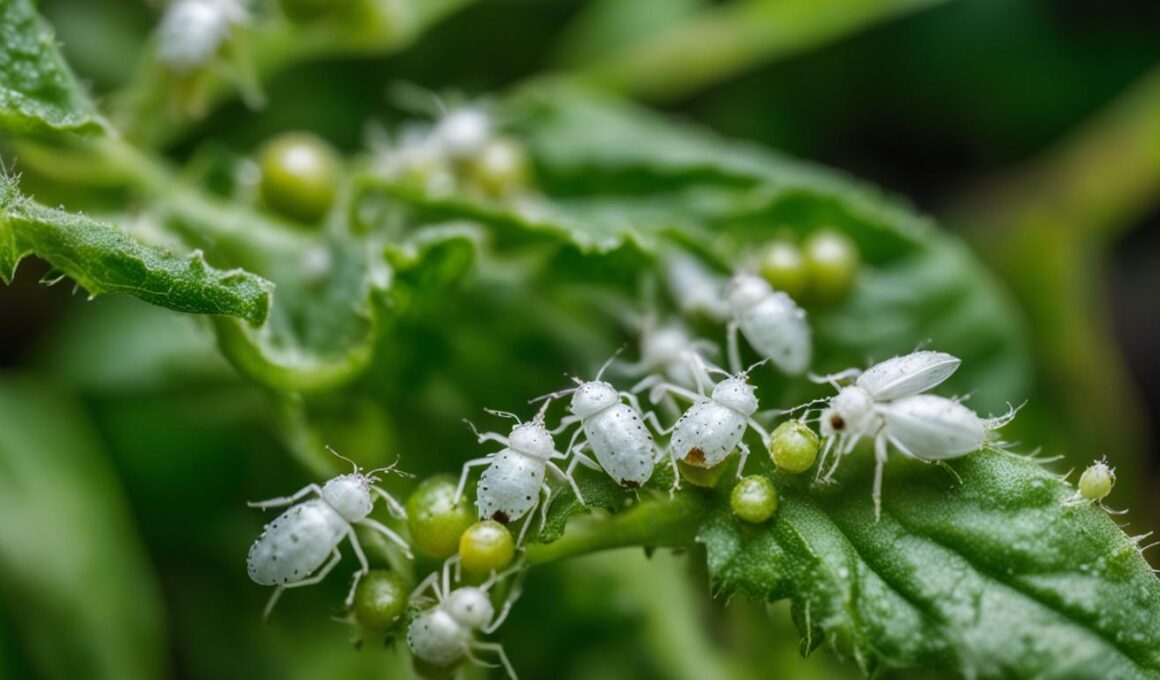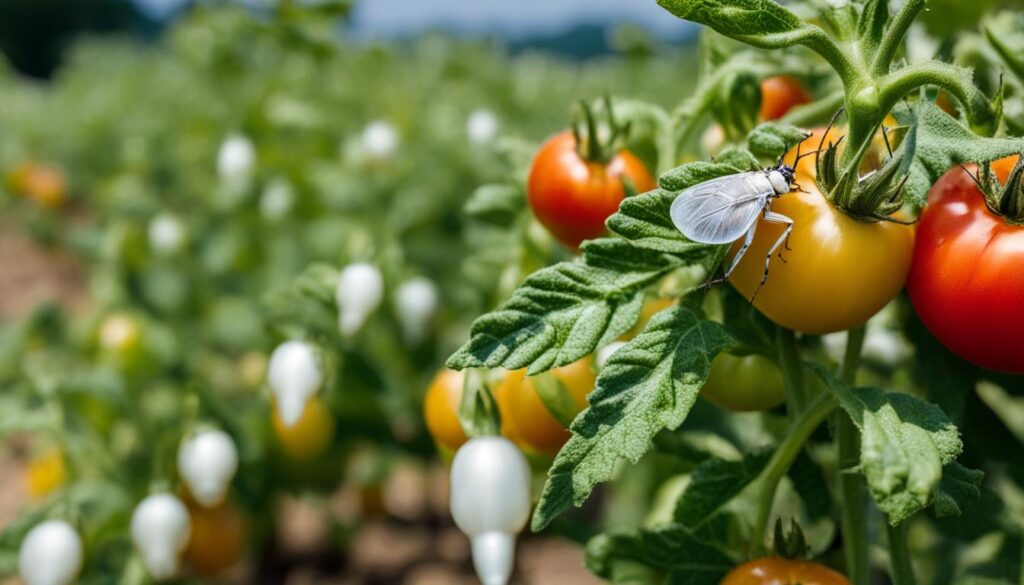If you’ve noticed white bugs on your tomato plants, you’re not alone. These tiny pests can wreak havoc on your precious crop. But don’t worry, we’re here to help you identify and understand the damage caused by these white bugs on your tomato plants.
Several species of whiteflies can infest tomato plants, but the two most commonly encountered are the sweetpotato whitefly and the greenhouse whitefly. These small, yellowish insects with white wings are about 0.06 inches (1.5 mm) long. Sweetpotato whiteflies hold their wings tilted over the body like a roof, while greenhouse whiteflies hold their wings flatter over the back.
These white bugs can cause significant damage to your tomato plants. They feed on the leaves, leading to yellowing and curling. You may also notice shiny or blackened leaves due to the sticky honeydew they produce. In addition, sweetpotato whiteflies can cause uneven ripening of tomato fruits, while greenhouse whiteflies have been found to be the vector of tomato infectious chlorosis virus.
Proper identification of the species is crucial for effective control. These whiteflies are typically found on the undersides of leaves and fly readily when plants are disturbed.
Now that you know what to look for, it’s time to take action and protect your tomato plants from these pesky white bugs. In the next sections, we will explore organic control methods and prevention techniques to help you keep your tomato plants healthy and thriving.
Organic Control Methods for White Bugs on Tomato Plants
A comprehensive integrated pest management program can effectively control whiteflies on tomato plants without the use of synthetic pesticides. By implementing organic control methods, you can protect your plants and promote a healthy, chemical-free environment. Here are some tips to help you manage white bugs organically:
- Cultural Practices: Create a favorable environment for beneficial insects that prey on whiteflies. Avoid over-fertilization and excessive use of nitrogen, as it can attract white bugs. Properly space and prune your tomato plants to improve airflow and reduce humidity, which can discourage whitefly infestations.
- Biological Control: Introduce natural enemies of whiteflies into your garden. Encourage and conserve populations of ladybugs, lacewings, and predatory mites, as they feed on whitefly eggs and nymphs. You can purchase these beneficial insects from reputable suppliers and release them near affected plants.
- Organic Insecticides: Utilize organic insecticides derived from plant-based ingredients, such as neem oil or insecticidal soap. These products suffocate and disrupt the life cycle of white bugs without harming beneficial insects or posing risks to human health. Follow the instructions on the label for proper application.
- Sticky Traps: Hang yellow sticky traps around your tomato plants to capture adult whiteflies. The bright yellow color attracts the bugs, and the sticky surface prevents them from flying away. Regularly monitor and replace the traps to maintain their effectiveness.
- Companion Planting: Intercrop your tomato plants with companion plants that repel whiteflies, such as marigolds, basil, or French marigolds. The strong scents emitted by these plants act as natural repellents, reducing the chances of whitefly infestations.
By implementing these organic control methods, you can effectively manage white bugs on your tomato plants while promoting a sustainable and eco-friendly garden. Remember to regularly inspect your plants for signs of infestation and act promptly to prevent the spread of whiteflies. With proper care and proactive measures, you can enjoy healthy and thriving tomato plants in your garden.
Prevention and Monitoring of White Bugs On Tomato Plants
To effectively manage whiteflies on your tomato plants, it is crucial to implement preventative measures and establish a monitoring system. By taking proactive steps, you can minimize their impact and ensure the health of your tomato plants. Here are some essential tips to help you with whitefly prevention, tomato plant pest monitoring, and whitefly treatment decisions.
1. Maintain a clean and healthy environment: Whiteflies are attracted to weak and stressed plants. Ensure your tomato plants receive adequate nutrition, water, and sunlight to promote robust growth. Regularly remove any weeds or debris in the vicinity to eliminate potential hiding spots for the pests.
2. Implement physical barriers: Install row covers or insect netting over your tomato plants to prevent adult whiteflies from laying eggs on the leaves. These barriers act as a physical deterrent, reducing the likelihood of infestation.
3. Introduce beneficial insects: Encourage the presence of natural predators such as ladybugs, lacewings, or parasitic wasps in your garden. These beneficial insects feed on whitefly eggs and larvae, providing natural control without the need for chemical pesticides.
4. Regularly monitor your plants: Check your tomato plants frequently for signs of whitefly infestation. Inspect the undersides of leaves where whiteflies typically hide. Look for yellowing, curling leaves, whitefly adults, eggs, or nymphs. Early detection allows for prompt action and prevents the infestation from spreading.
5. Implement appropriate treatment: If whiteflies are detected, consider using organic insecticidal soaps or neem oil as a targeted treatment option. These products effectively disrupt the life cycle of whiteflies while minimizing harm to beneficial insects and the environment. Follow the instructions carefully and apply treatments during the recommended times for optimal results.
By following these preventive measures and maintaining regular monitoring, you can effectively manage whitebugs on your tomato plants. Remember, early intervention is key to preventing the spread of infestations and preserving the health of your plants. Stay vigilant and take action as soon as any signs of whitefly activity are observed.
How Can White Bugs on Tomato Plants Affect Zucchini Plants and Their Harvest?
The presence of white bugs on tomato plants can lead to complications for zucchini plants and their harvest. These bugs can spread diseases like zucchini blossom end rot, affecting the overall health and yield of the zucchini plants. It is important to implement proper zucchini blossom end rot prevention methods to mitigate these risks.










